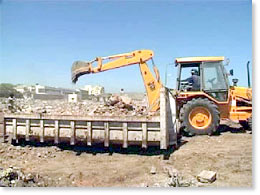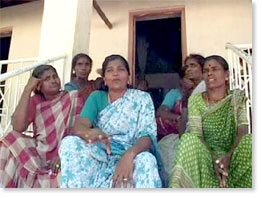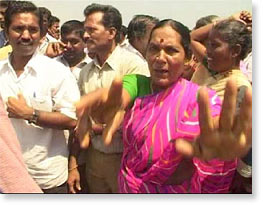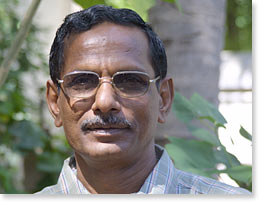|
Cynical Exploitation of Tsunami Victims
L.A. Samy is the director of AREDS (Association of Rural Education and Development Service) in the Tamil Nadu state of India. (Privatization, Commercialization, and Protests On the S.E. India Coast) by L.A. Samy Renganathapuram, Tamil Nadu, India
Tsunami is also capable of generating black humour. The joke that was making its rounds in Sri Lanka after the natural calamity struck its coastal areas: Some concerned scientists from abroad, after learning of the massive undersea earthquake near Sumatra, wanted to warn the Sri Lankan authorities of the impending tsunami waves. As the President Chandrika Kumaratunge was in London they tried to get in touch with the Prime Minister. As he was said to have gone for his morning walk, the frustrated scientists finally got through to the Army Headquarters and told them that tsunami was to reach Colombo any time from then. The Army officials asked for the correct spelling of the word and the language from which it originated and then sent some military officials to Colombo airport to receive the Japanese dignitary named T. Sunami. They came back and reported to the headquarters that no aircraft arrived at Colombo that morning carried any person with that name. By that time the real Tsunami most unwelcome in any part of the world, had already struck the seashores and the populace with all its fury. The joke, in its own lighthearted way, exposed the callousness on the part of the powers that be, whether it was Sri Lanka or in India or in any of the Asian and African countries which fell victims to the natural fury. As against the other tsunami-affected countries the Indian authorities had clearly one great advantage: Indian Air Force has a base on its Union Territory of the Andaman and Nicobar islands in the Bay of Bengal situated close to the epicenter of the earthquake. The Daily newspaper The New Indian Express carried a report saying that the airbase in Chennai was posted with a communication from the Nicobar Islands an hour before the tsunami struck the coastal districts of southern India that the Car Nicobar Island where the air base situated was sinking. No action was taken either by the military authorities or by their civilian counterparts, either at the Union level or at the State level. The Indian Government came out with an explanation that it has the mechanism to monitor the earthquakes occurring within the country, but does not have a similar one to receive warnings about and monitor the earthquakes occurring in other parts of the globe. Now, everyone from the Indian Government to the UN is talking about setting up a tsunami warning system. While the Indian Government has been seeking from the US the status of the most favoured nation, besides buying sophisticated military weapons and electronic espionage gadgets in addition to participating in joint military exercises, why was a system comparable to the one in the Pacific not established previously? The Indian Government cannot plead ignorance of suggestions made in October 2003 by seismologists to the International Coordination Group for Tsunami Warning System in the Pacific to extend its reach to the Indian Ocean. It is estimated that a hi-tech system covering all of the world’s oceans could be set up for about $150 million. Sea level gauges at $5,000 each (those linked to high-speed communications are about are four times more expensive) and the tsunameters, which detect the passage of a tsunami in deep water, cost $250,000 each and require regular maintenance. All these mechanisms including seismological input have to be linked to round-the-clock monitoring stations manned by trained scientific staff. Essential to all these are a program of training and education designed to make officials and the public aware of the dangers and for crisis management. The failure of the Indian Government to set up a tsunami warning system is indicative of its overall failure to effectively deal with natural calamities, such as flooding and cyclones that occur regularly throughout the country claiming several thousands of human and animal lives. While a section of India’s ruling elite blame the G-8 countries, particularly the US and Japan, for their failure to share the tsunami warning systems with India, the attitude of the Indian Government to handle the post-tsunami situation is determined by its ambition to maintain its status as a regional power. This is evident from its refusal of all offers of assistance from foreign aid groups particularly in Andaman-Nicobar islands. The only international organisation allowed to operate across the Andaman-Nicobar archipelago is UNICEF. Foreign journalists and aid workers have been confined to Port Blair, the capital of the Union Territory and not permitted to travel to any of the outlying islands. International aid groups have been permitted to provide assistance to local organizations, but even these activities have been restricted. Even the supplies sent by the International Red Cross are alleged to have been seized at the docks for distribution by government agencies themselves, while the plights of surviving victims of tsunami in these islands continue to be ignored. In the words of the Prime Minister Manmohan Singh, “India could demonstrate to the world its ability and capability to stand on its own feet”. But, according to Outlook (24 February 2005), nearly 70,000 persons still remain displaced in the ravaged islands; in the 13 islands of the Nicobar group, almost the entire surviving population is still in the relief camps; even the paltry interim compensation of Rs 2000 (less than $ 20) has not reached many families; rebuilding and repairing the sea walls are yet to be given priority despite the fact that thousands of acres of cultivable lands are still inundated by the sea water. In contrast, the Indian Government rushed medical and technical aid to Sri Lanka, the Maldives, and the Indonesian Province of Aceh. In its ‘Operation Sea Wave’ the Indian navy dispatched 32 ships to these countries within a week. However, responding to the wide spread disappointment over the Union Government’s handling of the situation; it was compelled to modify its stance. While continuing to reject aid from foreign countries, it has expressed its willingness to accept financial aid from the UN, the Asian Development Bank, the World Bank and the International Monetary Fund. While various aid groups and non-government organizations rushed to the affected areas immediately after the calamity occurred, the standoff between the state government and the central government delayed the urgently needed deployment of army for relief and rescue work. The dispute between the governments at two levels continues over how the central assistance is to be routed. Moreover, the confusion over whether the money for damaged and destroyed boats and nets would come in the form of loan or outright grant has not yet been cleared. The interim compensation given so far by the State Government has reached mainly to the supporters of the ruling party or is being cornered by the powerful local groups. The relief work is suddenly suspended and now the talk is about rehabilitation. Tsunami has displaced about 250,000 people. And now the people in the coastal belt are at the mercy of the State Governments and the NGO’s who dole out relief aids. Even after two months since tsunami devastated the coastal districts, the displaced people are in relief centers and for food and other basic needs like water look forward for to the charity groups. They are still stricken with grief over the death of their kith and kin and loss of all their personal belongings and properties and they are not considered either by the government departments or by the AID agencies as full-fledged human beings with desires, aspirations to work and live with self-worth. Now, even the pittance of relief measures are being given up in many places and the present talk is about rehabilitation. What kind of rehabilitation the state government is envisaging? Rehabilitation and partisan political gains The catchwords of the rehabilitation discourse of the State Government are the ‘Coastal Regulation Zone Notification (CRZ)’. According to this Central Government notification, there should be no buildings -- both residential and non-residential -- within a 1000 metres distance from the seashore. While the State Government has violated this regulation several times in the past such as construction of the East Coast Road to link Chennai with Kanyakumari for the benefit of the motorists who want to reduce the time of travel, it has often invoked these regulations against the interests of the working people, especially the fishers. In the 1980s there was an attempt by the Government led by the cine actor-turned-Chief Minister to remove the catamarans from the Marina Beach in Chennai with a view to beautify the beach. The move was given up only after the stiff resistance by the fishermen and women, the resistance that ended up in police firing. Two years ago the present Chief Minster of Tamil Nadu Ms Jeyalalithaa announced a Rs 1000 crore Tamil Nadu- Malaysian Government joint venture to construct residential buildings for the personnel belonging to multinational companies and foreign embassies. This project could not be implemented thanks to the standoff between the State and the Central Government. The standoff engineered by partisan political gains. Cynically exploiting the post-tsunami situation in the coastal areas and manipulating the CRZ regulations, the State Government is blatantly trying to promote eco-tourism and allowing the corporate and multinational sectors to construct buildings after forcibly evicting and relocating the people traditionally living along the sea shores in the name of their protection from future tsunami attacks. In fact, the CRZ regulations do recognize the traditional rights of the fishers: “ Construction/reconstruction of dwelling units between 200 and 500 metres of the High Tide Line is permitted so long as it is within the ambit of traditional rights and customary uses such as existing in fishing villages”. But, in contravention of this provision, the Special Commissioner and Commissioner of Revenue Administration Department of Government of Tamil Nadu, in his letter dated 19.1.2005 addressed to the District collectors of 13 coastal districts in Tamil Nadu, has instructed them to compulsorily relocate even those living within 500 metre distance from the seashore and take over the lands and buildings thus vacated. Tamil Nadu Government has already evicted the inhabitants of Dideer Nagar slum, which is close to Marina Beech in Chennai. Nearly 1500 families were evicted. The families that had their own houses before tsunami were given houses in a place 20 Km. away from Dideer Nager. As those who are living in rented houses before tsunami have not been given alternate houses for settlement, they continue to live either in dilapidated houses or in the open air in the same slum. The place chosen for their resettlement has no drinking water, transport, electricity, toilet and school facilities. When the residents of Kannagi Nagar, another seashore slum protested against compulsory relocation and went in for blocking the roads they were brutally lathi-charged (beaten up with canes) by the police who arrested 51 persons, including 15 women. The injured were not even given first aid but were straight away lodged in jail. Most of the evicted families are daily wage earners and their children have been forced to drop out from the schools, as there are no schools in the resettlement area. The people in the neighbourhood slum, Srinivasapuram, have been served with eviction notices. But they have sought the intervention of the Madras High Court which has mercifully granted temporary stay against eviction just as their counterpart in Anna Nagar Kuppam in Royapuram of North Chennai succeeded in getting a similar stay from forcible relocation in a place 10 km away from their traditional habitat. In the Rajakkamangakalam from Kanyakumari District people are not given temporary shelter even after two months of Tsunami but they were given notice to give consent to relocate them to a new place 500 meters away from coastal area. But 99% of the families have firmly said ‘no’ to the eviction proposal. Privatization and commercialization of coastal areas Despite the political rivalry between the party in power in the State Government of Tamil Nadu and the ruling alliance at the Centre, the government at two levels competes with each other in pushing the neo-liberal agenda over the dead and half-dead fishers. The proposal sent by the Tamil Nadu government in July 2004 to the Union Ministry for the development of mangrove-rich areas of Pichavaram in Cuddalore district at a cost of Rs 375.6 lakhs (37,560,000 rupees) has been sanctioned by the Central Government after the tsunami disaster occurred. In the group of islands where more than 100 lives were claimed by tsunami and from where the survivors fled to safer places is now targeted for eco-tourism. Rs. 540 Crores (5,400 million rupees) project for the development of the port at Nagapattinam that was pending for a long time is materializing now taking advantage of the situation where thousands of people have been displaced from the sea shores by the tsunami waves and also through invoking Coastal Regulation Zone notifications and forcible evictions. The other mega-project is the construction of International Tourism Convention Centre in Mahabalipuram at a cost of Rs 1400 crores (14,000 million rupees). One of the moves of the Tamil Nadu Government to protect the sea shores (not the people living there) from future tsunami attacks is to construct a compound wall for the entire coastal distance of 1000 kilometres from Chennai to Kanyakumari! The Central Government headed by Manmohan Singh has already come out with a Draft New Environmental Policy aiming to liberalise the Coastal Regulation Zones Notifications introduced in 1991. Tsunami has thus struck the coastal areas in yet another manner: it has paved the way for privatization of coastal areas and commercializing coastal regulation zones. Many forms of protest against forcible eviction from seashores and resettlement in places incompatible with the traditional livelihood of the people are taking shape. For example, Pattipulam panchayat (local government) comprised of four fishing villages in Kanchipuram district has passed a resolution on January 26 that the people of those villages would not allow themselves to be relocated from their traditional seashore settlements. Some areas in Nagapattinam people have launched an agitation calling for withdrawal of the eviction plan. But the feeble voice of protest is still to gain strength. All these struggles need to be articulated, coordinated and strengthened. In the meanwhile, the bane of Indian society -- the caste line -- keeps appearing much more ferociously than the tsunami waves. Dalits, or the untouchable and most oppressed castes in the caste order face discrimination even at places where relief is provided and rehabilitation work is said to have begun. They are discriminated on the one hand by members of the community of fishers, who themselves have suffered immense losses in terms of lives, properties and personal belongings, and on the other by the Government officials. Dalits in the fishing villages are not usually allowed to go to the sea for fishing but once the fishing boats are hauled back into the beach sands, they participate in the works such as collecting the fish, removing and drying the nets. In a number of tsunami-affected areas, the bodies of the Dalits killed by the waves had to be removed only with the help of the sanitary workers brought from far away places as the members of the fishers community were not willing to help dispose of these bodies. In the relief camps run by both the Government and Non-Government agencies, there were a number of reports on how the members of fishers community prevented the distribution of relief material and demanded that the Dalits be shifted to some other camps. The fishers, in turn also find themselves in such ugly situations; for them also there is no escape from the hierarchically organized prison system of the caste. According to Outlook (7 March 2005), the surviving fishers of Kallar village in Nagapattinam (where 103 died) are willing to be relocated in a wasteland. But a Hindu temple maintained by upper castes controls the wasteland. They don’t want the fishers to come near them, because in the words of a young fisher, “we stink in their perception”. Who said that death is the great leveler?
Published in In Motion Magazine March 22, 2005 Also see:
|
If you have any thoughts on this or would like to contribute to an ongoing discussion in the  What is New? || Affirmative Action || Art Changes || Autonomy: Chiapas - California || Community Images || Education Rights || E-mail, Opinions and Discussion || En español || Essays from Ireland || Global Eyes || Healthcare || Human Rights/Civil Rights || Piri Thomas || Photo of the Week || QA: Interviews || Region || Rural America || Search || Donate || To be notified of new articles || Survey || In Motion Magazine's Store || In Motion Magazine Staff || In Unity Book of Photos || Links Around The World NPC Productions Copyright © 1995-2018 NPC Productions as a compilation. All Rights Reserved. |






